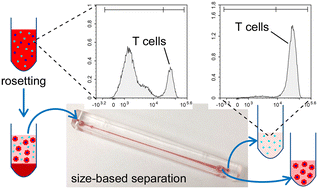Red blood cell rosetting enables size-based separation of specific lymphocyte subsets from blood in a microfluidic device
Abstract
The isolation of a specific lymphocyte subset from blood is the required first step in the manufacturing of many novel cellular immunotherapies. Microfluidic size-based separation methods are poised to significantly simplify this process because they require neither centrifugation nor magnetic or fluorescent labeling to operate. Lymphocytes can be separated from red blood cells (RBCs) and platelets as well as monocytes and granulocytes because their size differs from each of these cell types. However, further separation of a specific lymphocyte subset from other unwanted lymphocytes using size-based methods is impossible because all lymphocytes have approximately the same size and can only be distinguished by surface markers. This paper describes a new approach that made it possible for a size-based separation method to isolate a desired subset of lymphocytes by making unwanted lymphocytes as well as other blood cells artificially larger. The separation was enabled by selectively binding multiple RBCs to each unwanted cell to create ‘rosettes’ with an effective size significantly larger than the diameter of a typical lymphocyte. The desired lymphocytes remained unaffected by rosetting and were separated from the rosettes by passing the mixture through a microfluidic size-based separation device based on controlled incremental filtration (CIF). This new rosette-enabled size-based (RESIZE) separation approach demonstrated recovery of 80–90% for all lymphocyte subsets tested (CD3+, CD4+, CD56+) which was ∼2.5-fold higher than that for the standard immunodensity method (RBC rosetting followed by density gradient centrifugation). The purity of separation was >90% for CD3+ cells but declined with increasing cell rarity. Unlike the immunodensity approach, RESIZE required neither centrifugation nor cell washing after the separation and was ∼2.5-fold faster when processing the same sample volume. The results of this study suggest that integration of the RESIZE approach for high-yield isolation of lymphocyte subsets from blood could significantly streamline the manufacturing workflow and thus have a potentially transformative impact on the cost and availability of novel cellular immunotherapies.



 Please wait while we load your content...
Please wait while we load your content...